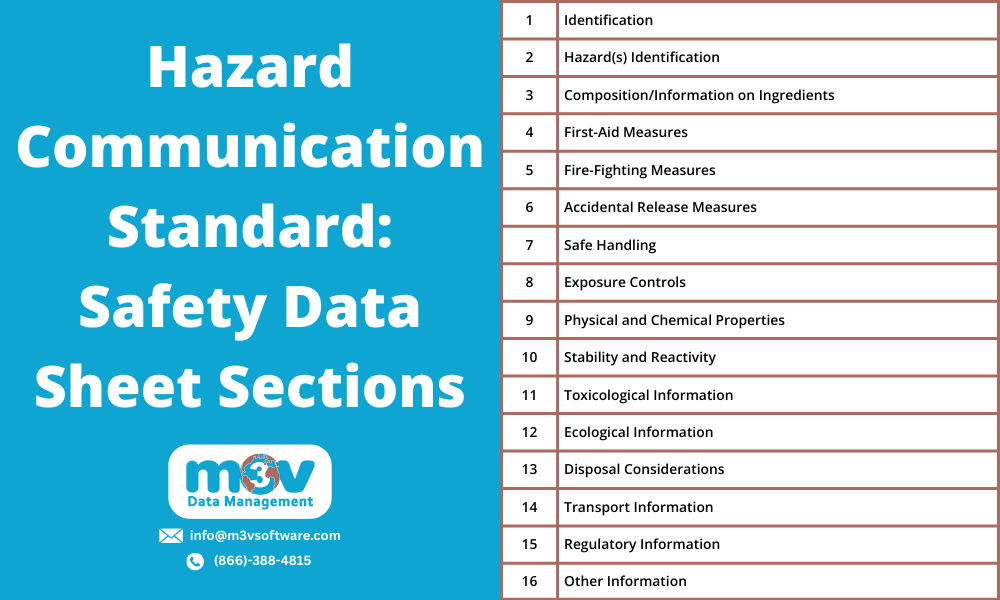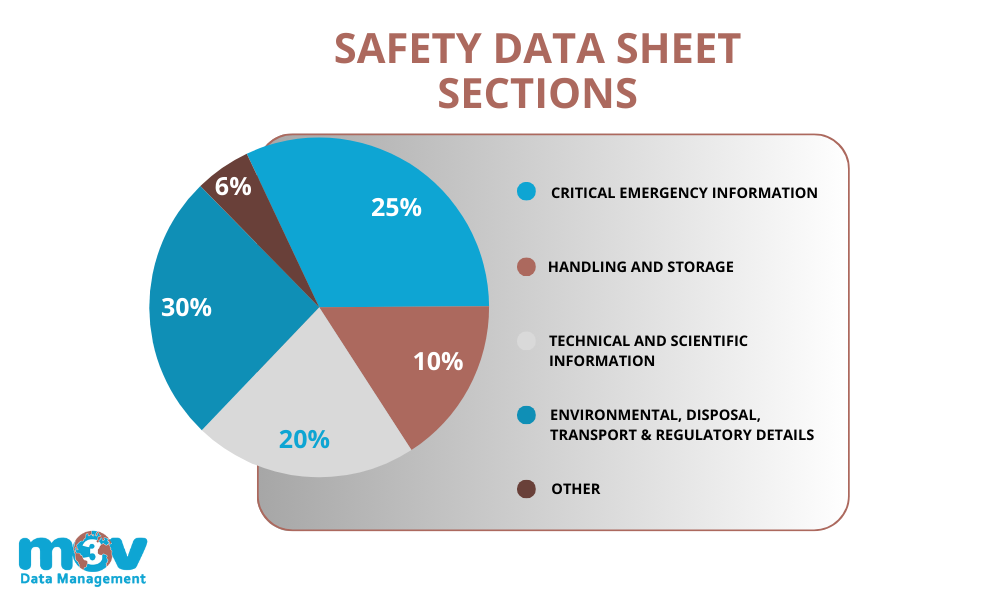Short Answer: An SDS (Safety Data Sheet) contains 16 standardized sections of critical safety information about chemical products, including hazard identification, composition, handling procedures, and emergency measures.
Safety Data Sheets (SDS) serve as the cornerstone of chemical safety in workplaces worldwide, providing essential information that helps protect workers, emergency responders, and the environment. These standardized documents have evolved from their predecessor, the Material Safety Data Sheet (MSDS), to align with the Globally Harmonized System (GHS) of Classification and Labeling of Chemicals, ensuring consistent safety communication across international borders.
Understanding the structure and content of an SDS is crucial for anyone who handles chemicals or manages workplace safety. This comprehensive breakdown will guide you through each of the 16 sections that comprise a modern SDS, explaining what information you’ll find and why it matters. Whether you’re an EH&S professional, safety manager, or someone responsible for chemical handling, this guide will help you navigate these critical documents with confidence.

The First Six Sections: Critical Emergency Information
The first six sections of a Safety Data Sheet (SDS) contain vital emergency response information that must be immediately accessible to workers, first responders, and safety personnel. These sections form the foundation for chemical safety and incident response protocols.
Section 1: Identification
Section 1 serves as the document’s introduction, providing essential identifying information about the chemical product and its manufacturer. This includes the product identifier that matches the label exactly, manufacturer or distributor name, address, and phone number, along with a 24-hour emergency contact number. The section also specifies recommended uses and any restrictions on use, ensuring proper product application and handling.
Section 2: Hazard(s) Identification
This crucial section outlines all potential hazards associated with the chemical, presented in a standardized format using GHS classification criteria. It features clear hazard pictograms, signal words (either “Danger” or “Warning”), hazard statements describing the nature of hazards, and precautionary statements outlining prevention and response measures. The section also addresses any hazards not otherwise classified (HNOC) and unknown acute toxicity information when relevant.
Section 3: Composition/Information on Ingredients
For single substances, this section provides the chemical name, common name(s), and Chemical Abstract Service (CAS) number. For mixtures, it lists all hazardous components present at or above 1% concentration (0.1% for carcinogens). Each ingredient entry includes:
- Chemical name
- Common name and synonyms
- CAS number
- Exact percentage (or percentage range) of each ingredient
- Any trade secret claims must be indicated according to OSHA requirements
Section 4: First-Aid Measures
This section provides clear, practical guidance for immediate care following exposure. The information is organized by exposure routes:
- Inhalation: Steps for moving to fresh air and restoring normal breathing
- Skin contact: Instructions for removing contaminated clothing and washing affected areas
- Eye contact: Proper eye-flushing procedures and duration
- Ingestion: Specific instructions about whether to induce or avoid vomiting
Each subsection describes both immediate and delayed symptoms and indicates when professional medical attention is required.
Section 5: Fire-Fighting Measures
This technical section guides firefighters and emergency responders on proper fire control methods. It details:
- Appropriate extinguishing media (water spray, foam, dry chemical, carbon dioxide)
- Unsuitable extinguishing methods that could increase hazards
- Specific hazards like toxic gases or explosion risks
- Special protective equipment requirements for firefighters
- Specific firefighting techniques and precautions
Section 6: Accidental Release Measures
The final emergency response section outlines procedures for containing and cleaning up spills or leaks. It includes:
- Required personal protective equipment for cleanup
- Environmental protection measures
- Containment methods for different spill sizes
- Proper cleanup techniques and materials
- Evacuation criteria and procedures
- Prevention of secondary hazards
Each step is presented in a clear, actionable format to ensure quick and appropriate response during emergencies.

Handling and Storage Sections
Sections 7-8 are critical sections of an SDS outline the safe handling practices, exposure controls, physical/chemical characteristics, and stability considerations essential for proper chemical management.
Section 7: Safe Handling
Section 7 provides detailed guidelines for safely handling and storing chemicals. For safe handling, it outlines specific precautions workers must take, including proper ventilation requirements, measures to prevent fires or explosions, and protocols to avoid generating aerosols or dust. Storage requirements detail optimal temperature ranges, container specifications, and storage area characteristics. This section also identifies incompatible materials and conditions that must be avoided during storage.
Section 8: Exposure Controls
This section focuses on protecting workers through three key control methods. First, it specifies exposure limits like Permissible Exposure Limits (PELs) and Threshold Limit Values (TLVs). Second, it details required Personal Protective Equipment (PPE), including specific types of gloves, eye protection, and respiratory equipment. Third, it outlines necessary engineering controls such as local exhaust ventilation, enclosed processes, or other mechanical systems to minimize exposure.
Technical and Scientific Information
Sections 9 through 11 of the Safety Data Sheet fall under the “Technical and Scientific Information” category. These sections provide a deeper look into the physical behavior, chemical stability, and toxicological impact of a substance, essential for safety professionals, lab personnel, and anyone responsible for handling or storing hazardous materials. While earlier sections focus on immediate hazard communication and protective measures, this portion of the SDS dives into the measurable, research-based data that supports risk assessment, regulatory compliance, and safe material usage.
Section 9: Physical and Chemical Properties
This detailed section provides crucial information about the substance’s inherent characteristics. It may includes:
- Physical state at room temperature
- Color and overall appearance
- Odor characteristics and detection thresholds
- pH level and concentration
- Melting, freezing, and boiling points
- Flash point for flammable materials
- Evaporation rate compared to standard substances
- Upper and lower flammability limits
- Vapor pressure and density measurements
- Solubility in water and other solvents
- Specific gravity or relative density
- Auto-ignition and decomposition temperatures
- Viscosity specifications
Section 10: Stability and Reactivity
Section 10 addresses the chemical’s stability under normal conditions and potential hazards from chemical reactions. It identifies conditions that could trigger dangerous reactions, including exposure to heat, light, or pressure. This section lists materials that must be avoided due to incompatibility and details possible hazardous decomposition products. It also specifies whether the substance may undergo hazardous polymerization and outlines environmental conditions that could affect its stability. Understanding this information is crucial for proper storage planning and risk assessment.
Section 11: Toxicological Information
Section 11 provides critical health hazard data that helps users understand the potential risks of chemical exposure. This section details both immediate and long-term health effects through various exposure routes. Companies must report specific symptoms that may occur through inhalation, skin contact, eye contact, or ingestion. The information is typically presented in clear, clinical terms, focusing on measurable effects and documented research.
For chemicals with known or suspected carcinogenic properties, this section includes detailed carcinogenicity classifications from organizations like IARC, NTP, or OSHA. Numerical measures of toxicity, such as LD50 (Lethal Dose 50%) values, provide quantitative data about a substance’s toxic effects. Interactive effects with other chemicals or medical conditions are also outlined when known.
Environmental, Disposal, Transport & Regulatory Details
While OSHA does not enforce the content of Sections 12 through 15, these areas are included in the SDS to align with the Globally Harmonized System (GHS). They cover important information related to environmental impact, waste disposal, transportation safety, and applicable regulatory frameworks—often governed by agencies outside OSHA’s jurisdiction. Understanding these sections is essential for maintaining compliance with environmental and transport regulations and for ensuring safe handling throughout a chemical’s life cycle.
Section 12: Ecological Information
Environmental impact data in Section 12 helps organizations understand how chemicals affect ecosystems. This section examines a substance’s behavior in nature, including its persistence (how long it remains active in the environment), degradability (how it breaks down), and bioaccumulative potential (whether it builds up in living organisms).
The aquatic toxicity data specifically addresses effects on fish, invertebrates, and algae, while terrestrial information covers impacts on soil organisms and plants. This section also discusses the chemical’s mobility in soil and potential for groundwater contamination, crucial for environmental risk assessment and spill response planning.
Section 13: Disposal Considerations
Proper disposal guidance ensures compliance with environmental regulations while protecting human health and the environment. This section outlines specific containers and handling procedures required for safe disposal, considering the chemical’s physical and chemical properties that might affect disposal methods.
Organizations must pay special attention to warnings about sewage disposal and specific landfill requirements. Local disposal regulations are referenced, though users should note these may vary by jurisdiction. When applicable, recycling recommendations are provided to promote sustainable waste management practices.
Section 14: Transport Information
Transportation requirements ensure safe material handling during shipping. The UN number and proper shipping name provide standardized identification for hazardous materials. Transport hazard classes and packing group numbers indicate the level of danger and required packaging integrity.
This section also covers environmental hazards specific to transportation, such as marine pollutant status. Special handling instructions and bulk transport considerations help prevent accidents during shipping. Emergency response guide information provides quick reference for first responders in case of transportation incidents.
Section 15: Regulatory Information
The regulatory section compiles applicable safety, health, and environmental regulations. This includes specific industry requirements, chemical inventory listings, and workplace hazard communications standards. Organizations use this information to ensure compliance with various regulatory frameworks, from OSHA requirements to environmental protection standards.
Other Information
Section 16: Other Information
The final section provides context for the entire SDS document. It includes preparation and revision dates, helping users verify they have the most current information. A key to abbreviations ensures a clear understanding of technical terms, while data sources establish the document’s credibility.
When revisions occur, this section highlights significant changes, helping users identify updated information quickly. Technical contacts and references provide resources for additional information, while disclaimer statements clarify the document’s intended use and limitations.

Mastering SDS Management with M3V
Understanding the 16 sections of a Safety Data Sheet is crucial for workplace safety and regulatory compliance. From hazard identification and first-aid measures to handling procedures and toxicological information, each component plays a vital role in protecting workers and ensuring proper chemical management. Maintaining up-to-date SDSs isn’t just a legal requirement—it’s essential for creating a safe working environment and making informed decisions about hazardous chemical handling and emergency response.
Best practices for SDS management include maintaining a centralized digital repository, implementing regular review cycles, and ensuring easy accessibility for all employees. However, managing hundreds or thousands of SDSs can be overwhelming without the right tools. This is where M3V Data Management’s specialized software solutions become invaluable. Our web-based EH&S software streamlines SDS management, automates updates, and ensures GHS compliance, allowing safety professionals to focus on what matters most—protecting their workforce.
Ready to transform your SDS management process? Contact M3V Data Management today to discover how our intuitive software can simplify your regulatory compliance and enhance workplace safety.




